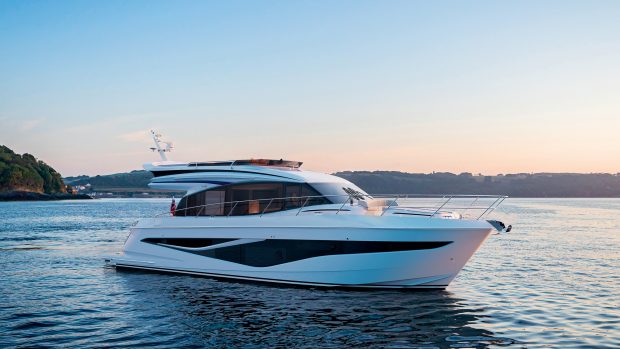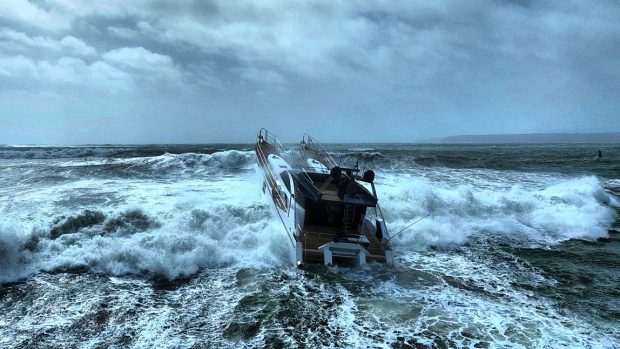A team of French scientists has developed a tear drop-shaped catamaran that gets more efficient the faster it goes. Could this be the future of fast boats?
If you thought the current trend for foiling boats resulted in some strange looking craft you ain’t seen nothing yet!
A specialist shipyard in La Rochelle, France has started building a range of wing-shaped catamarans that rely on aerodynamics rather than hydrodynamics to help them ‘fly’ over the water.
Known as Advanced Aerodynamic Vessels, or A2Vs, they are capable of speeds up to 50 knots while also halving the fuel consumption of a typical craft of this size and pace.
Article continues below…

McConaghy MC63p: First look at Grant Dalton’s new foiling powercat

Sunreef 100 Power superyacht tour: Inside a mind-blowing €14million mega-cat
They work by taking advantage of an aerodynamic phenomenon known as wing-in-ground effect. Conventional plane wings are shaped in such a way that as they pass through the air they generate low pressure on the top side and high pressure on the underside.
The combined effect is lift. The closer the wing is to the ground, or in this case the surface of the sea, the more efficient it becomes as the high-pressure air is sandwiched between two surfaces. This is even more effective in the case of a catamaran as the hulls prevent the high-pressure air escaping from the side as well, creating more lift relative to speed.
A number of high performance catamarans and even some monohulls, such as Ice Marine’s Bladerunner series, already take advantage of this air entrapment effect to generate some lift and reduce drag through the water, but they also have to manage that lift to reduce the risk of the whole craft flipping at speed.

Two A2Vs are already in service as fast ferries
The difference with the A2V is that the entire craft is shaped like a wing, rather than just the deck section spanning the two hulls, and by keeping the centre of gravity well forward there is no danger of the bow lifting too high. One of the ways they do this is by locating the passenger compartment right at the front of the boat.
Passengers actually sit inside the wing itself, just behind the leading edge where the cross section is at its widest point. The helmsman sits on his own above the passenger compartment in an aircraft-style glass bubble cockpit.
A2V ferries: Tried and tested
The team behind the A2V has already spent over seven years developing the project and its original 10.5m prototype built in 2015 has completed more than 5000nm of testing in waves of up to 2m and wind speeds of up to 30 knots. It has now built two slightly larger 12m (39ft) high-speed passenger ferries for commercial clients, the most recent of which has just entered service in the Port of Monaco.
Powered by twin 350hp Yanmar 8LV diesel engines linked to surface drives for maximum high-speed efficiency, this 6.2 tonne catamaran can ferry 12 passengers in consummate luxury at a sustained cruising speed of 45 knots while burning just 2.5 litres per nautical mile – around half the amount used by a high-speed ferry.
More excitingly for readers of MBY, A2V has now released details of a leisure version for private owners wanting the ultimate fast cruiser for shuttling to and from their favourite beach, island or superyacht. A clever articulated roof and drop-down side panels allows the unusual teardrop-shaped aft section to open up at rest and reveal a sheltered cockpit area with sunpads, dinettes and side-mounted bathing platforms. Doors lead forward from here to a master suite or a pair of smaller VIP cabins.
Rather than relying on costly, complex and hard to manoeuvre surface drives, the leisure version will use a pair of standard 300hp outboard engines. Their lighter weight and smooth-running petrol powerheads will still allow for a stop speed of 50 knots but the cruising range from the twin 350-litre tanks will drop from the diesel model’s 250nm to around 150nm, albeit at the same 45-knot speed.

Twin 300hp outboard engines are hidden under lifting transom panels on the leisure model
Fast and efficient
It is this ability to maintain such a high cruising speed without inflicting a heavy fuel penalty that sets the A2V apart from almost every other vessel on the market. That’s because whereas most boats generate more drag the faster they go, requiring more power and heavier engines to compensate for it, the A2V creates less drag as lift reduces the wetted surface area.
In terms of litres per mile it’s actually more efficient towards the top end of its speed range than the mid-range. In other words you’ll use less fuel blasting to the beach at 45 knots than you will taking it easy at 30 knots. If that doesn’t sound like the perfect excuse for putting the hammers down we don’t know what does!
A2V Diesel specifications
LOA: 39ft 0in (11.9m)
Beam: 23ft 0in (7.45m)
Draft: 2ft 0in (0.6m)
Displacement: 6,200kg
Fuel tanks: 2 x 350 litres
Engines: 2 x 350hp Yanmar 8LV diesel
Propulsion: Surface drives
Max speed: 50 knots
Cruising speed: 45 knots
Fuel consumption: 2.5l/nm @ 45 knots
Range: 250nm @ 45 knots
CE category: B for 12 + 1
First published in the June 2021 issue of Motor Boat & Yachting.
If you enjoyed this…
Be first to all the latest boats, gadgets, cruising ideas, buying advice and readers’ adventures with a subscription to Motor Boat & Yachting. Available in both print and digital formats, our monthly magazine will be sent directly to your home or device at a substantial discount to the usual cover price. See our latest offers and save at least 30% off the cover price.

Folding side platforms create additional deck space

The leisure version features an articulated roof

Doors lead from the aft cockpit into two cabins under the raised helm position










